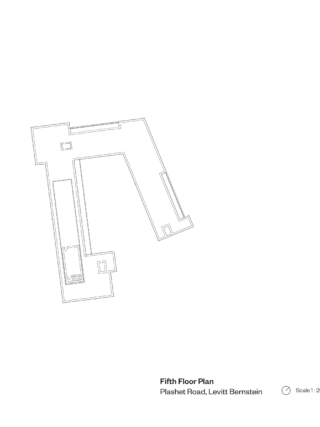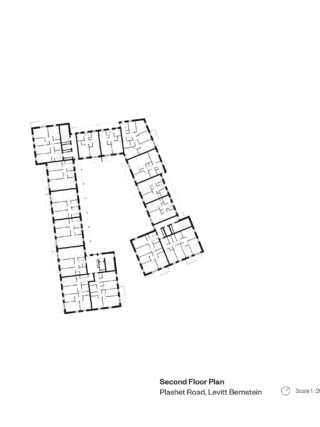Levitt Bernstein’s Passivhaus-certified social housing for Newham Council adds new affordable and sustainable units in East London.
Levitt Bernstein has delivered its inaugural Passivhaus-certified social housing development for the London Borough of Newham. Known as Plashet Road, the scheme comprises 65 affordable homes and a nursery, designed to meet the council’s ambitious sustainability targets. The development replaces an underutilised site and introduces low-energy homes that prioritise residents’ well-being.
Nicola Jaques, associate at Levitt Bernstein, spoke to Architecture Today about the studio’s approach to the site. “Preservation of the boundary of perimeter trees was a priority, so the new homes needed to sit inside of this, with a green buffer created between the surrounding streets and front gardens. Initial studies showed that the number of new homes could be optimised through a courtyard development with a shared amenity space at its heart. Multiple communal entrances would be required, each one creating views through to the garden within.”
As a result, a series of twelve mature plane trees encircle the site. Located in a densely urban context, the building’s footprint has been carefully set back to provide generous green buffers and a landscaped central courtyard, creating a tranquil environment for residents and the community.
First, second, third, fourth and fifth floors.
Drawing inspiration from the local vernacular, a diamond-patterned red brick plinth runs along the lower façade, referencing traditional brickwork found in neighbouring streets – a detail that scales the building to complement the human interaction at street level and the height of the surrounding tree canopy.
The project’s circulation strategy integrates both internal shared routes and deck access, ensuring dual-aspect homes with optimal orientation and natural ventilation. Deck access routes and balconies were designed in response to the site’s orientation and environmental conditions, positioning balconies to the south or west to maximise daylight and solar gain, while placing access decks on the north or east where larger windows are less critical – an arrangement that enhances the quality of living spaces and facilitates passive surveillance onto the courtyard and surrounding streets. Larger units, such as three-bedroom homes, are situated on corners with windows placed on outer-facing walls, ensuring privacy and enhanced daylight levels.
This approach to mapping out units to make the most of daylight was in line with the project’s Passivhaus ambitions. “We worked closely with our in-house sustainability team and with Etude to develop the layouts and massing, adopting a fabric-first approach and a set of design principles which responded to the site orientation and Passivhaus criteria,” said Jaques.
Will South, Passivhaus designer at Etude, highlighted the advantages of the standard: “The rigour of the Passivhaus standard helped focus on delivering a high-quality building, through quality checks of calculations, documentation, and construction by the independent Passivhaus Certifier, Warm. The outcome will be low energy bills and low carbon emissions for residents, over the entire life of the building.”
Windows have been carefully designed to meet Passivhaus standards, balancing daylight optimisation, ventilation, and heat loss minimisation. “The detail of the design was carefully honed against Passivhaus principles as it evolved,” added Jaques. By incorporating inset brick surrounds, the design enhances the perceived size of the windows, providing a more harmonious façade composition. Balustrades and balconies meanwhile combine brick elements for privacy with metal railings, promoting natural ventilation and daylight through adjacent glazed doors that lead in to living rooms behind. Opening vents above fixed panes also increase ventilation efficiency, maintaining the Passivhaus commitment to reduced energy consumption.
The building layout also strategically positions living spaces away from access decks, with kitchens, bathrooms, and storage areas occupying north and east orientations. Doing so ensures dual or triple aspects for each home, with one aspect always facing a quiet area to allow secure natural ventilation and cross ventilation in one- and two-bedroom units.
Although the project employs a concrete structural frame, studies carried out by structural engineers resulted in various proposals which were assessed to minimise embodied carbon. “The option with the smallest volume of each was agreed upon to help reduce embodied carbon and layouts were adjusted to suit,” said Jaques.
In addition to the 65 units provided – of which 48 are family units – is a nursery. Designed to be flexible and cater for various community programming uses, the space aims to provide support residents of all ages.
“We are proud to have delivered 65 low-energy homes at Plashet Road,” added Jaques. “This project embodies our commitment to creating people-focused, high-quality housing that is sustainable, inclusive, and accessible.”
Credits
Client
London Borough of Newham
Architect
Levitt Bernstein
Structural engineer
Heyne Tillett Steel
Mechanical and engineering consultant
Max Fordham
Quantities surveyor
Philip Pank Partnership
Passivhaus consultant
Etude
Sustainability consultant
XC02
Daylight Sunlight consultant
XCo2
Fire consultant
Joule Group
Landscape consultant
Levitt Bernstein
Acoustic consultant
Max Fordham
Principal designer
Levitt Bernstein
Main contractor
Bugler Developments
Note: Levitt Bernstein and Etude were the only consultants to continue post-planning, working for the contractor along with the delivery team.






























